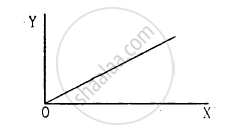Advertisements
Advertisements
Question
Two wires of diameter 0.25 cm, one made of steel and the other made of brass are loaded as shown in Fig. 9.13. The unloaded length of steel wire is 1.5 m and that of brass wire is 1.0 m. Compute the elongations of the steel and the brass wires.

Solution 1
Elongation of the steel wire = 1.49 × 10–4 m
Elongation of the brass wire = 1.3 × 10–4 m
Diameter of the wires, d = 0.25 m
Hence, the radius of the wires, `r=d/2` = 0.125 cm
Length of the steel wire, L1 = 1.5 m
Length of the brass wire, L2 = 1.0 m
Total force exerted on the steel wire:
F1 = (4 + 6) g = 10 × 9.8 = 98 N
Young’s modulus for steel:
`Y_1 = (F_1/A_1)/(triangleL_1/L_1)`
Where,
ΔL1 = Change in the length of the steel wire
A1 = Area of cross-section of the steel wire = `pir_1^2`
Young’s modulus of steel, Y1 = 2.0 × 1011 Pa
`:.triangleL_1 = (F_1xxL_1)/(A_1xxY_1) = (F_1xxL_1)/(pir_1^2xxY_1)`
`= (98xx1.5)/(pi(0.125 xx 10^(-2))^2 xx 2 xx 10^11) = 1.49 xx 10^(-4)m`
Total force on the brass wire:
F2 = 6 × 9.8 = 58.8 N
Young’s modulus for brass: `Y_2 = (F_2/A_2)/((triangleL_2)/L_2)`
Where
`triangleL_2` = change in length
`A_2` = Area of cross-section of the brass wire
`:.triangleL_2 = (F_2xxL_2)/(a_2xxY_2) = (F_2xx L_2)/(pir_2^2 xx Y_2)`
`= (58.8 xx 1.0)/(pixx(0.125xx10^(-2))^2 xx (0.91xx10^(11))) = 1.3xx10^(-4)m`
Elongation of the steel wire = 1.49 × 10–4 m
Elongation of the brass wire = 1.3 × 10–4 m
Solution 2
For steel wire total force on steel wire
F1 = 4+6 = 10 kg f = 10 x 9.8 N
l1 = 1.5 m, Δl1 = ?; 2r1 = 0.25 cm
or `r_1 = (0.25)/2 cm = 0.125xx 10^(-2) m`
`Y_1 = 2.0 xx 10^11` Pa
For brass wire, F2 = 6.0 kg f = 6 x 9.8 N
2r2 = 0.25 cm
or `r_2 = (0.25/2) = 0.125 xx 10^(-2) m`
`Y_2 = 0.91 xx 10^11 Pa`, `l_2 = 1.0 m` `trianglel_2 = ?`
Since` Y_1 = (F_1xxl_1)/(A_1xxtrianglel_1) = (F_1xxl_2)/(pir_1^2 xx trianglel_1) => trianglel_1 = (F_1xxl_1)/(pir_1^2xxtrianglel_1)`
or `trianglel_1 = ((10xx9.8)xx1.5xx7)/(22xx(0.125xx10^(-2))^2xx2xx10^11) = 1.49 xx 10^(-4) m`
And `trianglel_2 = (F_2xxl_2)/(pir_2^2 xx Y_2) = ((6xx9.8)xx1xx7)/(22xx(0.125xx10^(-2))^2xx(0.91xx10^11)) = 1.3 xx 10^(-4) m`
APPEARS IN
RELATED QUESTIONS
A 14.5 kg mass, fastened to the end of a steel wire of unstretched length 1.0 m, is whirled in a vertical circle with an angular velocity of 2 rev/s at the bottom of the circle. The cross-sectional area of the wire is 0.065 cm2. Calculate the elongation of the wire when the mass is at the lowest point of its path.
Two wires A and B are made of same material. The wire A has a length l and diameter rwhile the wire B has a length 2l and diameter r/2. If the two wires are stretched by the same force, the elongation in A divided by the elongation in B is
A student plots a graph from his reading on the determination of Young modulus of a metal wire but forgets to put the labels. the quantities on X and Y-axes may be respectively

(a) weight hung and length increased
(b) stress applied and length increased
(c) stress applied and strain developed
(d) length increased and the weight hung.
A steel rod of cross-sectional area 4 cm2 and 2 m shrinks by 0.1 cm as the temperature decreases in night. If the rod is clamped at both ends during the day hours, find the tension developed in it during night hours. Young modulus of steel = 1.9 × 1011 N m−2.
Young's modulus of a perfectly rigid body is ______.
If the yield strength of steel is 2.5 × 108 Nm–2, what is the maximum weight that can be hung at the lower end of the wire?
A boy's catapult is made of rubber cord which is 42 cm long, with a 6 mm diameter of cross-section and negligible mass. The boy keeps a stone weighing 0.02 kg on it and stretches the cord by 20 cm by applying a constant force. When released, the stone flies off with a velocity of 20 ms-1. Neglect the change in the area of the cross-section of the cord while stretched. Young's modulus of rubber is closest to ______.
A uniform metal rod of 2 mm2 cross section is heated from 0°C to 20°C. The coefficient of linear expansion of the rod is 12 × 10-6/°C, it's Young's modulus is 1011 N/m2. The energy stored per unit volume of the rod is ______.
If the length of a wire is made double and the radius is halved of its respective values. Then, Young's modules of the material of the wire will ______.
The force required to stretch a wire of cross section 1 cm2 to double its length will be ______.
(Given Young's modulus of the wire = 2 × 1011 N/m2)
